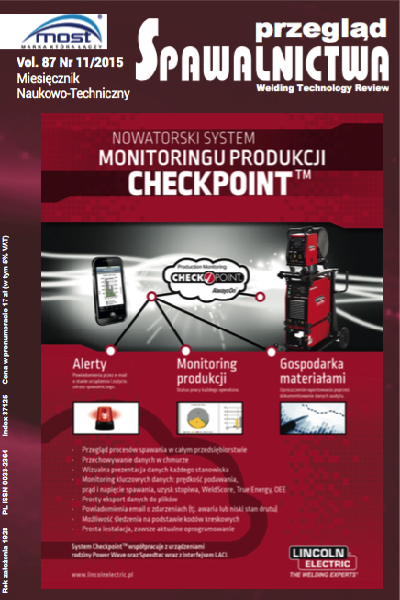Plasma spheroidisation of high melt point materials on example of tungsten
Main Article Content
Abstract
Particle shape and size, density and distribution are important characteristics of the powders processed by additive manufacturing processes e.g. Selective Laser Melting (SLM) or Electron Beam Melting (EBM). Spherical shape of powder particles allows to stably carrying out the process and affects also the manufactured objects properties. Desired morphology of the powder can be achieved by powder manufacturing process or by additional treatment of the non-spherical powders. This paper is dedicated to study spheroidization of tungsten powder by Atmosphere Plasma Spraying (APS). Influence of APS process parameters and preliminary powder treatment has been analysed. Scanning electron microscopy (SEM) was used for the evaluation of shape, size and distribution of post-processed powder particles.
Sferoidyzacja plazmowa materiałów o wysokiej temperaturze topienia na przykładzie wolframu
Abstract
Kształt oraz wielkość cząstek, gęstość oraz rozkład są istotnymi cechami charakterystycznymi proszków przetwarzanych za pomocą technologii przyrostowych n.p. selektywnej laserowej mikrometalurgii proszków (SLM) lub elektronowej mikrometalurgii proszków (EBM). Sferyczny kształt cząstek proszku umożliwia stabilne prowadzanie w/w procesów oraz wpływa na własności wytwarzanych nimi obiektów. Oczekiwana morfologia proszku może być osiągnięta za pomocą jego procesu wytwarzania, jak również poprzez dodatkową obróbkę proszków niesferycznych. Artykuł jest poświęcony badaniom sferoidyzacji proszku wolframu za pomocą natryskiwania plazmowego (APS). Został przeanalizowany wpływ parametrów procesu oraz wstępnej obróbki proszku. Do oceny kształtu, wielkości i dystrybucji otrzymywanych cząstek proszku została zastosowana skaningowa mikroskopia elektronowa (SEM).
Downloads
Article Details
Creative Commons CC BY 4.0 https://creativecommons.org/licenses/by/4.0/
Welding Technology Review (WTR) articles are published open access under a CC BY licence (Creative Commons Attribution 4.0 International licence). The CC BY licence is the most open licence available and considered the industry 'gold standard' for open access; it is also preferred by many funders. This licence allows readers to copy and redistribute the material in any medium or format, and to alter, transform, or build upon the material, including for commercial use, providing the original author is credited.
References
ASTM F2792-10. Standard Terminology for Additive Manufacturing Technologies.
Scott J., Gupta N., Weber C., Newsome S., Wohlers T., Caffrey T., Additive Manufacturing: Status and Opportunities, Science and Technology Policy Institute, 2012.
Wohlers T., Wohlers Report: Additive Manufacturing and 3D printing, State of the Industry, Wohlers Associates Inc., 2013.
Khan M., Selective Laser Melting (SLM) of Gold (Au), PhD Thesis, Loughborough University, UK 2010.
Majewski T., Badanie procesów modyfikacji plazmowej proszków W i Re oraz mieszanek W-Re, Biuletyn WAT, Vol. LX, Nr 2, 2011.
Majewski T., Dębski A., Badania procesu sferoidyzacji proszku wolframu i molibdenu w strumieniu plazmy, Biuletyn WAT, Vol. LVI, Nr 3, 2007.
Fauchais P., Montavon G., Bertrand G., From Powders to Thermally Sprayed Coatings, Journal of Thermal Spray Technology, 2010, Volume 19, Issue 1-2, pp. 56-80.
Wrona A., Sejda-Leszczyńska K., Lis M., Czepelak M., Mazur J., Bilewska K., Woch M., Chmielarz A., Staszewski M., Osadnik M., Sferyczne proszki ze stopów renu z kobaltem i niklem, Rudy i Metale Nieżelazne, 2013, numer 12, s. 828-834.
Woch M., Missol W., Lis M., Ksieżarek S., Badania Instytutu Metali Nieżelaznych nad wykorzystaniem renu w przetwórstwie metali nieżelaznych, Rudy i Metale Nieżelazne, 2011, numer 5, s. 266-271.
Kurzynowski T., Chlebus E., Kużnicka B., Reiner J. Parameters in selective laser melting for processing metallic powders, Proceedings of SPIE The International Society for Optical Engineering, 8239, art. no. 823914. ISBN: 978-081948882-4, doi: 10.1117/12.907292
Leżański J., Proszki metali i wysokotopliwych faz. Metody wytwarzania, Wydawnictwa AGH, Kraków 1994.
Majewski T., Investigation of W-Re-Ni Heavy Alloys Produced From Plasma Spheroidized Powders, Solid State Phenomena Vol. 199 (2013), pp 448-453. doi: 10.4028/www.scientific.net/SSP.199.448.
Boulos M., Plasma power can make better powders, Metal Powder Report, Vol. 59, Issue 5, May 2004, P. 16-21. doi:10.1016/S0026- 0657(04)00153-5.
Majewski T., Modification of W and Re Powders by Plasma Technique, Solid State Phenomena Vol. 165 (2010), pp. 130-135.
Majewski T., Research of Spheroidization Processes of W-Re Powders, Solid State Phenomena Vol. 199 (2013), pp. 490-495.
Planetary Mono Mill, Pulverisette 6. Access link http://www.asi-team.com/asi%20team/fritsch/Fritsch%20data/pulverisette6-1.pdf
A. Lawley, Atomization: The Production of Metal Powders, MPIF, Princeton, NJ, USA, 1992.
M. Entezarian, F. Allaire, P. Tsantrizos Ph.D., R. A. L. Drew Ph.D., Plasma atomization: A new process for the production of fine, spherical powders, JOM, Volume 48, Issue 6 (1996), pp 53-55.
Huiping Li, Xucheng D.., Prediction of powder particle size during centrifugal atomisation using a rotating disk, Science and Technology of Advanced Materials, Volume 8, Issue 4, (2007), pp. 264-270.
Minagawa K., Kakisawa H., Osawa Y., Takamori S., Halada K., Production of fine spherical lead-free solder powders by hybrid atomization, Science and Technology of Advanced Materials, Volume 6, Issues 34, AprilMay 2005, pp. 325-329.
Wrona, A. Leszczyńska-Sejda, K. Lis, M. Benke, G. Czepelak, M. Anyszkiewicz, K. Mazur, J. Bilewska, K. Chmielarz, A. Woch, M. Staszewski, M. Osadnik, M. Orłowska-Buzek, Ł. Kozub, K. Gambal, P. Satora, W. Spherical powders of rhenium-based alloys with cobalt and nickel, Rudy i Metale Nieżelazne, R. 58/ 12 (2013), pp. 828-834.
